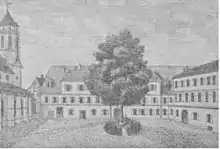South Slavic Bible Institute
The South Slavic Bible Institute[1] (German: Südslawische Bibelanstalt)[2] was established in Urach (modern-day Bad Urach) in January 1561 by Baron Hans von Ungnad, who was its owner and patron.[3] Ungnad was supported by Christoph, Duke of Württemberg, who allowed Ungnad to use his castle (former convent) of Amandenhof near Urach[4] as a seat of this institute.[5]
 The seat of the South Slavic Bible Institute: 1910 drawing of the castle (former convent) of Amandenhof | |
| Founder(s) | Hans von Ungnad |
|---|---|
| Established | January 1561 |
| Mission | to spread Protestantism among all South Slavs through printing liturgical books in Glagolitic, Latin, and Cyrillic script |
| President | Primož Trubar |
| Staff | Stjepan Konzul Istranin, Antun Dalmatin, Jovan Maleševac and Matija Popović |
| Key people | Hans von Ungnad |
| Location | former convent of Amandenhof , , |
| Dissolved | 1565 |
Baron Ungnad was interested in Protestant proselytism propagated by Primož Trubar and attended the session of German theologians held in Tübingen in 1561.[4] At that occasion Ungnad, probably instructed by Duke Christoph, agreed that he would take responsibility for publishing Slavic books.[4]
Within the institute, Ungnad set up a press which he referred to as "the Slovene, Croatian and Cyrillic press" (German: Windische, Chrabatische und Cirulische Trukherey).[3] The manager and supervisor of the institute was Primož Trubar.[3] The books they printed at this press were planned to be used throughout the entire territory populated by South Slavs between the Soča River, the Black Sea,[6] and Constantinople.[7] Trubar intended to use the books to spread Protestantism among Croats and other South Slavs.[8] For this task, Trubar engaged Stjepan Konzul Istranin and Antun Dalmatin as translators for Croatian and Serbian.[9] The Cyrillic text was the responsibility of Antun Dalmatin.[10] The type for printing the Cyrillic-script texts was cast by craftsmen from Nuremberg.[11] The first attempt to use it failed, and the type had to be reconstructed.[5] In 1561 in Tübingen three small books were printed (including Abecedarium and Catechismus) in Croatian[12] in the Glagolitic script. The same books were also printed in Ulach in Serbian with the reconstructed Cyrillic type.[5][12] Juraj Juričić worked as a copy reader at the institute from 1562 to 1563.[13]
The language used by Dalmatin and Istranin was based on the northern-Chakavian dialect with elements of Shtokavian and Ikavian.[14] People from the institute, including Trubar, were not satisfied with Dalmatin and Istranin's translations.[14] Trubar admonished the two in heated correspondences about the correctness of the language they used even before the first edition translated by Dalmatin and Istranin was published, and immediately thereafter.[15] For a considerable amount of time, the institute tried to employ a certain Dimitrije Serb to help Istranin and Dalmatin, but without success.[16] Eventually, they managed to employ two Serbian Orthodox priests - Jovan Maleševac from Ottoman Bosnia and Matija Popović from Ottoman Serbia.[16]
The institute and its press were operational until Ungnad died in 1565.[7]
References
- Betz 2007, p. 54.
- Vorndran 1977, p. 8.
- Society 1990, p. 243.
- Review 1988, p. 388.
- Breyer 1952, p. 32.
- Črnja 1978, p. 117.
- Klaić 1974, p. 71.
- Rotar 1988, p. 17.
- Lubotsky, Schaeken & Wiedenhof 2008, p. 280.
- Društvo 1972, p. 595.
- Sakcinski 1886, p. 103.
- Balkanologie 1977, p. 147.
- Slovenski biografski leksikon: Jurij Juričič.
- Mošin & Pop-Atanasov 2002, p. 18.
- štamparija 1922, p. 261.
- Матица 1976, p. 112.
Sources
- Society (1990). Slovene Studies: Journal of the Society for Slovene Studies. The Society.
- Črnja, Zvane (1978). Kulturna povijest Hrvatske: Temelji. Otokar Keršovani.
- Betz, Hans Dieter (30 June 2007). Religion past and present. Brill.
- Klaić, Vjekoslav (1974). Povijest Hrvatâ od najstarijih vremena de svršetka XIX stoljeća. Matica hrvatska.
- Breyer, Mirko (1952). O starim i rijetkim jugoslavenskim knjigama: bibliografsko-bibliofilski prikaz. Izdavački zavod Jugoslavenske akademije znanosti i umjetnosti.
- Lubotsky, Alexander; Schaeken, J.; Wiedenhof, Jeroen (1 January 2008). Evidence and Counter-evidence: Balto-Slavic and Indo-European linguistics. Rodopi. ISBN 90-420-2470-4.
- Sakcinski, Ivan Kukuljević (1886). Glasoviti hrvati proslih vjekova: niz zivotopisa. Naklada "Matice hrvatske".
- Review (1988). The Slavonic and East European review.
- Vorndran, Rolf (1977). Südslawische Reformationsdrucke in der Universitätsbibliothek Tübingen: e. Beschreibung d. vorhandenen glagolit., kyrill. u. a. Drucke d. Uracher Bibelanst. Franz Steiner Verlag. ISBN 978-3-16-939761-7.
- Društvo (1972). Bibliotekar. Društvo bibliotekara N.R. Srbije.
- Rotar, Janez (1988). Trubar in Južni Slovani. Državna zal. Slovenije.
- Mošin, Vladimir A.; Pop-Atanasov, Ǵorgi (2002). Izbrani dela. Menora.
- Матица (1976). Review of Slavic studies. Matica srpska.
- štamparija (1922). Prilozi za književnost, jezik, istoriju i folklor. Drzhavna štamparija Kralevine srba, khrbata i slovent︠s︡a.
- Balkanologie (1977). Zeitschrift für Balkanologie. R. Trofenik.